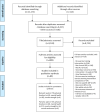Which specific modes of exercise training are most effective for treating low back pain? Network meta-analysis
- PMID: 31666220
- PMCID: PMC7588406
- DOI: 10.1136/bjsports-2019-100886
Which specific modes of exercise training are most effective for treating low back pain? Network meta-analysis
Expression of concern in
-
Expression of concern: Which specific modes of exercise training are most effective for treating low back pain? Network meta-analysis.Br J Sports Med. 2020 Sep 3:bjsports-2019-100886eoc1. doi: 10.1136/bjsports-2019-100886eoc1. Online ahead of print. Br J Sports Med. 2020. PMID: 32139370
Abstract
Objective: Examine the effectiveness of specific modes of exercise training in non-specific chronic low back pain (NSCLBP).
Design: Network meta-analysis (NMA).
Data sources: MEDLINE, CINAHL, SPORTDiscus, EMBASE, CENTRAL.
Eligibility criteria: Exercise training randomised controlled/clinical trials in adults with NSCLBP.
Results: Among 9543 records, 89 studies (patients=5578) were eligible for qualitative synthesis and 70 (pain), 63 (physical function), 16 (mental health) and 4 (trunk muscle strength) for NMA. The NMA consistency model revealed that the following exercise training modalities had the highest probability (surface under the cumulative ranking (SUCRA)) of being best when compared with true control: Pilates for pain (SUCRA=100%; pooled standardised mean difference (95% CI): -1.86 (-2.54 to -1.19)), resistance (SUCRA=80%; -1.14 (-1.71 to -0.56)) and stabilisation/motor control (SUCRA=80%; -1.13 (-1.53 to -0.74)) for physical function and resistance (SUCRA=80%; -1.26 (-2.10 to -0.41)) and aerobic (SUCRA=80%; -1.18 (-2.20 to -0.15)) for mental health. True control was most likely (SUCRA≤10%) to be the worst treatment for all outcomes, followed by therapist hands-off control for pain (SUCRA=10%; 0.09 (-0.71 to 0.89)) and physical function (SUCRA=20%; -0.31 (-0.94 to 0.32)) and therapist hands-on control for mental health (SUCRA=20%; -0.31 (-1.31 to 0.70)). Stretching and McKenzie exercise effect sizes did not differ to true control for pain or function (p>0.095; SUCRA<40%). NMA was not possible for trunk muscle endurance or analgesic medication. The quality of the synthesised evidence was low according to Grading of Recommendations Assessment, Development and Evaluation criteria.
Summary/conclusion: There is low quality evidence that Pilates, stabilisation/motor control, resistance training and aerobic exercise training are the most effective treatments, pending outcome of interest, for adults with NSCLBP. Exercise training may also be more effective than therapist hands-on treatment. Heterogeneity among studies and the fact that there are few studies with low risk of bias are both limitations.
Keywords: analgesics; behavioural symptoms; catastrophization; physical activity; physical therapy modalities; rehabilitation; spine.
© Author(s) (or their employer(s)) 2020. Re-use permitted under CC BY-NC. No commercial re-use. See rights and permissions. Published by BMJ.
Conflict of interest statement
Competing interests: None declared.
Figures



Comment in
-
Letter in response to: 'Which specific modes of exercise training are most effective for treating low back pain? Network meta-analysis' by Owen et al.Br J Sports Med. 2021 Mar;55(5):285-286. doi: 10.1136/bjsports-2019-101812. Epub 2020 Feb 5. Br J Sports Med. 2021. PMID: 32024645 No abstract available.
-
Editorial comment on discussion: 'Which specific modes of exercise training are most effective for treating low back pain? Network meta-analysis'.Br J Sports Med. 2021 Mar;55(5):246-247. doi: 10.1136/bjsports-2020-103467. Epub 2020 Oct 8. Br J Sports Med. 2021. PMID: 33032990 No abstract available.
References
Publication types
MeSH terms
LinkOut - more resources
Full Text Sources
Medical
